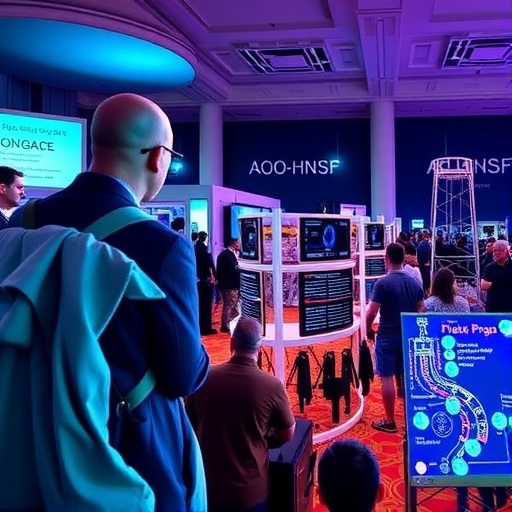The 2025 Annual Meeting and OTO EXPO hosted by the American Academy of Otolaryngology–Head and Neck Surgery Foundation (AAO-HNSF) concluded its highly anticipated scientific program, unveiling a wealth of pioneering studies that are set to reshape clinical practice across otolaryngology. This day of presentations highlighted the specialty’s unwavering commitment to rigorous research and cutting-edge innovation, addressing complex questions from the molecular level to population health. Participants at the conference witnessed compelling evidence that pushes the envelope in understanding ear, nose, and throat disorders while optimizing patient outcomes.
One of the conference’s landmark revelations was the definitive association between conductive hearing loss and elevated dementia risk, a frontier that deepens the existing link traditionally seen with sensorineural hearing loss. The study leveraged data from nearly 400,000 subjects in the expansive All of Us Research Program cohort, uncovering that individuals afflicted with cholesteatoma present 3.7-fold higher odds of developing dementia. Tympanic membrane perforation and otosclerosis were also independently associated with 3.2 and 2.1 times increased dementia risk, respectively. Crucially, this research delineates conductive hearing loss as a purely peripheral pathology, excluding neural causation, which suggests that sensory deprivation itself is a significant driver of cognitive decline. These findings underscore the imperative for early diagnosis and possibly surgical intervention aimed at mitigating neurodegenerative trajectories.
Further expanding the investigation of lifestyle and environmental determinants of auditory health, researchers presented a multi-center propensity-score matched cohort analysis quantifying cannabis use’s impact on tinnitus risk. This robust study, involving over 87,000 matched pairs, elucidated a 15% increased short-term risk of tinnitus diagnosis post-cannabis-related disorder, escalating to a 63% increment in users exhibiting dependency behaviors. Intriguingly, this risk attenuates over extended follow-up, implying a complex, temporally dynamic relationship that demands further exploration into underlying pathophysiological mechanisms. Such nuanced insights prompt clinicians to weigh cannabis’s otologic effects carefully during patient evaluations.
In contrast to some prevailing expectations, a meticulous retrospective analysis interrogating the relationship between air pollution—specifically fine particulate matter (PM2.5)—and sinonasal malignancies found no statistically significant correlation. Examining clinical records from 148 surgical patients, this study challenges the assumed carcinogenic role of airborne pollutants concerning these rare tumor types. These counterintuitive results highlight sinonasal cancers’ multifactorial etiology and emphasize the necessity for larger, multi-institutional trials to dissect the interplay of environmental exposures in tumor pathogenesis more conclusively.
Surgical innovation and safety optimization also featured prominently, with a comprehensive review of over 10,000 head and neck free flap cases investigating the timing and efficacy of pharmacologic deep vein thrombosis (DVT) prophylaxis. Data revealed that postoperative administration significantly reduces complications, including flap failure—achieving a 34% reduction in bony and 25% in non-bony reconstructions—as well as lowering revision surgery rates. Conversely, prophylactic measures initiated on the same day as surgery did not influence outcomes compared to no prophylaxis, offering critical evidence to refine perioperative thromboprophylaxis protocols balancing thrombosis prevention against the risk of compromised flap perfusion.
Laser technology advancements for in-office laryngeal management garnered notable attention. Evaluating 539 procedures across 168 patients with pathologies ranging from benign papillomatosis to invasive squamous cell carcinoma, researchers compared blue light and potassium-titanyl-phosphate (KTP) laser modalities. Both demonstrated high safety profiles with minimal adverse events; however, KTP laser yielded significantly longer recurrence-free intervals in premalignant and carcinoma in situ lesions—averaging 244 days versus 137 days for blue light. This nuanced efficacy differentiation informs tailored laser selection, potentially enabling improved outpatient care paradigms for early laryngeal neoplasms.
Pediatric otolaryngology insights emerged from an extensive 20-year national surveillance endeavor examining emergency department visits attributable to nasal foreign bodies. The analysis estimated approximately 690,000 cases, with jewelry items constituting the majority, followed by paper products, desk supplies, and toys—the latter primarily composed of building set components. Alarmingly, foreign bodies such as batteries and coins correlated with substantially higher risks of hospital admission or transfer, by factors of 18.44 and 6.55 times respectively. These findings underline the urgent need for targeted parental education, particularly for children under five, to avert potentially life-threatening complications.
On the genetic and developmental front, studies focusing on primary ciliary dyskinesia (PCD) patients illuminated the extensive otologic burden this population endures. Data showed that 65% experienced hearing loss necessitating multiple tympanostomy tube placements, with persistent otorrhea in 91% despite intervention, and ongoing hearing impairment in 58%. Speech delays affected over half of patients, and 19% required individualized education plans, underscoring critical gaps in early detection and audiologic management. This research advocates for reinforced genetic screening pathways and proactive surveillance to mitigate developmental deficits.
Diagnostic testing paradigms were rigorously evaluated in the context of cerebrospinal fluid (CSF) otorrhea, focusing on the utility of beta-2-transferrin testing. Although this assay boasts high specificity, its average six-day turnaround delays clinical decision-making, as skull base precautions and lumbar drains are often initiated pre-results. Surgical decisions, however, appeared influenced by confirmation from testing, suggesting clinicians might strategically reserve beta-2-transferrin assays for ambiguous or complex cases rather than routine use, balancing cost and impact considerations.
Technological device safety was highlighted through a comparative investigation of percutaneous versus transcutaneous bone conduction implants. The study’s cohort of 91 implants reported a striking disparity in complication rates—60% for percutaneous devices versus 21% for transcutaneous—with percutaneous systems exhibiting a 5.54-fold elevated odds of complications. Although the majority were classified as minor, these findings convey significant implications for patient counseling and device selection, particularly amid considerations of long-term auditory rehabilitation efficacy and quality of life.
Cross-cultural and anatomical variations were examined in a novel East-West study addressing symptomatic sigmoid sinus wall anomalies in pulsatile tinnitus patients. Remarkably, body mass index (BMI) disparities were evident, with U.S. patients averaging 33.5 kg/m² compared to 23.8 kg/m² in Asian counterparts. These demographic nuances suggest distinct etiologic pathways and possibly divergent clinical phenotypes, warranting region-specific diagnostic frameworks and therapeutic interventions tailored to patient populations’ unique characteristics.
Challenging established surgical dogma, computational fluid dynamic modeling explored the consequences of total inferior and middle turbinectomy on nasal airflow patterns and the development of Empty Nose Syndrome (ENS). Simulations revealed that extensive turbinate removal alone failed to reproduce the aberrant airflow distortions characteristic of ENS, contesting the notion that turbinectomy volume is the lone pathogenic factor. These findings prompt a re-evaluation of ENS’s complex pathophysiology, potentially guiding surgeons towards more conservative tissue preservation strategies and stimulating further research into the syndrome’s multifactorial basis.
Finally, patient-centered perspectives were integral to an exploration of decisional conflict and regret among individuals undergoing gender-affirming facial surgery. Surveys of 22 patients depicted remarkably low regret and high satisfaction levels, highlighting the critical roles of comprehensive preoperative counseling, surgeon expertise, and robust support systems in facilitating informed, confident surgical choices. This research provides a framework for enhancing shared decision-making processes in complex reconstructive interventions, emphasizing psychological and social determinants of surgical success.
Collectively, the 2025 AAO-HNSF Annual Meeting’s scientific program exemplifies the specialty’s extraordinary scope—spanning surgical technique refinement, environmental health inquiries, pediatric otolaryngology surveillance, and advanced diagnostic tool assessments—heralding a new era of evidence-based otolaryngology that promises transformative impacts on patient care worldwide. This wealth of research not only amplifies understanding of otolaryngologic conditions but also fosters innovations that integrate patient safety, technological advancement, and personalized medicine, propelling the field toward unprecedented clinical excellence.
Subject of Research: Otolaryngology–Head and Neck Surgery, Hearing Loss and Dementia, Auditory Health, Surgical Safety, Pediatric Otolaryngology, Diagnostic Testing, Device Complications, Airflow Modeling, Gender-Affirming Surgery.
Article Title: Breakthrough Research at the 2025 AAO-HNSF Annual Meeting Reveals New Insights Across Otolaryngology.
News Publication Date: October 14, 2025.
Web References:
“Conductive Hearing Loss Pathologies are Associated with Dementia in the All of Us Research Program”: https://cdmcd.co/YKbXr3
“Association Between Cannabis Use and Tinnitus”: https://cdmcd.co/bRP9p7
“Airborne Risks: Examining a Link Between Pollution and Sinonasal Malignancies”: https://cdmcd.co/PnwDdK
“An Assessment of Pharmacologic Deep Vein Thrombosis Prophylaxis on Head and Neck Free Flap Outcomes”: https://cdmcd.co/PnwDDE
“Efficacy and Safety of Blue Light and KTP Lasers for In-Office Treatment of Laryngeal Pathologies”: https://cdmcd.co/d6vzXj
“Consumer Trends in Pediatric Nasal Foreign Bodies”: https://cdmcd.co/3R9Kyn
“Hearing and Developmental Challenges in Patients with Primary Ciliary Dyskinesia”: https://cdmcd.co/nRPAnk
“Does Beta-2-Transferrin Testing Affect Decision Making in Patients with CSF Otorrhea?”: https://cdmcd.co/EdRpmP
“Comparison of Complication Rates Between Percutaneous and Transcutaneous Bone Conduction Devices”: https://cdmcd.co/9W7DbM
“Clinical Characteristics of Patients with Symptomatic Sigmoid Sinus Wall Anomalies: East vs West”: https://cdmcd.co/ZKYWyz
“Does Total Inferior and Middle Turbinectomy Always Lead to Empty Nose Syndrome?”: https://cdmcd.co/gaWERP
“Decisional Conflict and Regret in Gender-Affirming Facial Surgery: A Patient Perspective”: https://cdmcd.co/ABRxpL
References: Provided via linked studies at the AAO-HNSF Annual Meeting & OTO EXPO program page.
Keywords: Otolaryngology, Hearing Loss, Dementia, Cannabis, Tinnitus, Sinonasal Malignancy, DVT Prophylaxis, Laser Therapy, Pediatric ENT, Primary Ciliary Dyskinesia, CSF Otorrhea, Bone Conduction Implants, Sigmoid Sinus Wall Anomalies, Empty Nose Syndrome, Gender-Affirming Surgery.
Tags: AAO-HNSF Annual Meeting 2025cholesteatoma and cognitive declineconductive hearing loss and dementia riskinnovative treatments for ENT disordersneurocognitive implications of hearing lossOTO EXPO clinical insightsotolaryngology research advancementsotosclerosis and dementia associationpatient outcomes in hearing losspopulation health in otolaryngologyscientific program highlights in otolaryngologytympanic membrane perforation studies





